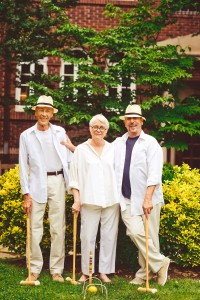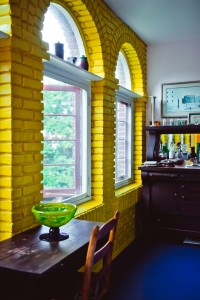
What first-class apartment house in Baltimore can rent you apartments of 3 bedrooms, bath, parlor, dining room and kitchen from $540 to $660 A YEAR! Where can you find rates approaching these in an equally good building and equally good locality? There may be some, but we have never heard of them. CALVERT COURT 4 choice apartments left. Better hurry….
There’s no typo in the above text, but before you pack your bags, know that this advertisement was posted in the Baltimore Sun on Sept. 23, 1915. Apologies. Still, if you’re looking for a character-rich, reasonably priced place to live, it’s worth noting that Calvert Court, the 32-unit co-op apartment house at 3024 N. Calvert Street, which turns 100 this year, is currently readying one basement unit for sale. Price is to be determined, but the typical dwelling goes for well under $200,000, even in 2015.

at a croquet-themed Friday happy hour in the courtyard.
The gorgeous red brick, five-building (A to F), courtyard-sharing complex was designed by esteemed local architect Edward H. Glidden, who also designed the city’s Homewood Apartments, Canterbury Hall and Tudor Hall, where he resided from 1915 until his death in 1924. Most apartments in Calvert feature a (currently rarely used but working) dumbwaiter, a (working) and oft-used fireplace and a long, lazy sun porch or solarium with enormous arched windows. Each building houses two-story apartments of approximately ,200 to ,400 square feet, except for the C building, which consists entirely of “flats” or single-story homes. As you climb the stairs to reach any address, enjoy open-air balconies planted with bright petunias (*see below—please don’t jump).
What would you need to know before you committed to making an offer at Calvert Court? What should you strive to possess to make it past the vigilant board of resident shareholders who look for certain reliable and creative qualities in an applicant?
Dead Bodies
Calvert Court is a place steeped in stories and legends, and the people who live here—newcomers and longstanding residents alike—are keen to swap them. They do so with flair. Like the Case of the Disappearing Wife, which I’ve heard reported at least three ways.
“Sometimes I would come over and watch a game with the husband,” says Jim Reed, Calvert Court’s chief maintenance man for the past 30 years. “He and his wife didn’t talk to each other—they communicated through their cats. One Sunday, he called me to come up there. He said, ‘I haven’t seen my wife in two days.’ So I opened her bedroom door—he didn’t go in there—and I found her lying in bed. ‘I’m afraid your wife is deceased’, I told the man. ‘Oh,’ he said. He didn’t get up. And from there, he continued to watch the game.”
“There’s a stain on the floor still,” says David Bergman, a Towson University literature professor who lived in Calvert Court with his husband, John Lessner,

from 1998 to 2003, when the couple moved nearby to better accommodate their dogs.
Then there’s the spooky story of Calvert Court’s last maintenance man, long ago murdered in the doorway of his basement apartment by a deranged lover with a knife, who found herself shipped off to Sheppard Pratt later that winter. The gruesome story doesn’t bother Reed, 63, a patient man with light eyes and a lean build, who has served quite serenely as the massive building’s main caretaker for three decades, keeping up with the luxurious flowering grounds as painstakingly as he does his tidy gray mustache. Reed plans to retire in 2017, at which point he’ll exit the same building D apartment where the stabbing happened.
“It’s not true that anybody was eaten by a cat,” Reed says with a slight curl of the lip. “That’s a tall tale.”
However, it is repeatedly rumored to be true that one former male resident died and was subsequently eaten by his dog or dogs. My friends (and longtime Calvert residents) James Magruder and Steve Bolton remind me to track down that narrative, and I vow to try before filing. The answer seems to trail the former Calvert Court chap to New York City, where suicide commenced pre-dog-consumption.
Heart and Architecture
Jot this specific on your cheat sheet: The building functioned as rented apartments from 1915 to 1947, when the flip to co-op occurred.

“I think the transition had to do with people coming back from the war and having new ideas of how to organize living space,” Bergman, 65, says. “And still in N.Y. co-ops are very, very popular for all kinds of reasons. They’ve never caught on in Baltimore. In a co-op, everyone pulls everyone together. There really is a remarkable community that develops. There is that kind of intimacy involved in looking out for people.”
Magruder and Bolton welcome me inside their vintage-chic, two-story space on the third and fourth floors of building A. Cerulean blue walls enliven the art-decked living room (a long portrait by the Baltimore Glassman echoes the color); a bold, nearly neon green wakes up the dining room; terra-cotta walls soften the guest room; the sun porch is an extra-bright crayon yellow with purple floor, the combination of which Magruder, a fiction writer and dramaturge, compares to a funky Mexican restaurant.
“That’s the second fittest graybeard at Calvert Court,” says Magruder pointing at the courtyard below where a muscular fellow in exercise clothes swivels a hula-hoop around his hips. The same slim man, who retired from Social Security, also hosts a book club that is spending three years reading and interpreting “The Divine Comedy” by Dante. Who’s the fittest older male resident of all? That would be Bolton, Magruder’s life partner, a research nurse at Hopkins.
The 50-something couple bought their place in 2000 for $60,000.
“It was like a training bra for a real-life house,” says Magruder, who had never owned a home before and worried about the heavy-duty commitments, both romantic and real estate. Now he

finds himself on the Calvert Court board and can’t imagine living anywhere else in town. “Steve was an empty-nester who was downsizing. And he lived on a commune in the ’60s. [He already knew] he likes community-based life.”
Though the array of residents is now fairly diverse in terms of race, sexual orientation and age, most occupants are about 50 or older, with the exception of a few well-mannered Hopkins students whose parents acquired the apartments expressly for their kids’ college years. There are also several professional couples in their mid-30s, including Patricio Simari, a professor at Catholic University, and his wife, Ada Tieman Simari, a finance officer on the Homewood campus of Hopkins. He is South American—she is American Southern.
Inspiringly, the historic building has since its early days seemed to serve as a safe haven for gay people, both in and out of the closet.
“It’s an architectural wonderland of sorts,” Bergman says. “It attracts people who are gay and lesbian and has always attracted people—actors and painters and some people walking by who always wanted to live there.”
A few decades back, Magruder tells me, gay applicants sometimes pretended to be straight to win their lease. Of course, board members have since been replaced and social mores thankfully revised.

“My lover, Mark, and I paid $8,000 for a three-bedroom apartment with a working fireplace, a solarium, dining room, kitchen, a dumbwaiter to send groceries up from the maid’s chamber,” says Michal Makarovich, a former theater director who owns the Junque boutique in Hampden. “We pretended we were brothers because the regulations said residents were to be families. And gay people weren’t families at that point. There were two gay guys who lived below us and drove a Mercedes who were very tasteful—we were trashy queers. We went to the gay clubs and dressed in bellbottoms! I played loud music. After we broke up, Mark caught holy hell from the board because a bunch of my friends helped me move out on a Sunday.”
Which brings us to the board. Ready for introductions? Wait, before we discuss the current president, one more quick story. It’s about the value of co-op living—I think—but mostly I just like it.
“Chuck lived at Calvert Court into his 90s—he was a teacher and gay,” Bergman says. “And he liked rough trade. And one day, his neighbor came out to me and said, ‘Chuck’s door is open to his apartment, and I’m afraid to go in.’ He entertained unseemly characters well into his 90s. With the door open, we were all concerned about him. Anyway, we both went in together. Chuck wasn’t there. Then Chuck arrived! He was just back from the gym. He had forgotten to lock the door. Since he was in his 90s, anything could have happened to him. He was surprised to find us there, but wasn’t upset at all. That’s the story I tell about people looking after each other.”
The Board
OK. If you’re smitten and want to become a shareholder at Calvert Court—because that’s what you’ll be if you sign the basement lease, someone who owns not a single apartment but “shares” in this charming old building—you and your finances will be reviewed carefully by a panel who wants to know that you’ll treat your space with care and your fellow tenants with respect

(wanting to know their versions of the dead body stories couldn’t hurt).
Professor Bergman was president for a stretch when he lived at Calvert Court—he filled in for a predecessor whose wife’s pregnancy spurred their move—but promises he never wanted to be.
“I would come back from the meetings and cry,” Bergman says, laughingly. “One of the forsythia had died. We had a 45-minute discussion of what flower to replace it with. There was an inverse proportion between length of discussion and importance.”
During Bergman’s administration, he proudly abolished the no-dogs rule, but says he regrets that he had to jack up the monthly fee that each tenant contributes to maintenance and property taxes and such.
Today’s Calvert Court president is one Vernon George, a bespectacled African-American man in his early 50s married to a bespectacled woman named Tirza Chavez, also in her early 50s. Chavez was born in Panama. The two run a home business that provides accounting services to artists.

“The concept of a co-op is wonderful,” George says. Among his favorite elements: the feeling he gets that he lives inside a village of apartment dwellers inside a town, Charles Village, inside a city, Baltimore. He also appreciates the fact that so many residents hold advanced degrees and pursue fascinating hobbies. “You own shares and you’re part of a system that you share with other folks, and you have a community that works together for each other to maintain and improve the property over time.”
Not that the board will reject creative or idiosyncratic rehab proposals out of hand, but they will weigh them in cautious balance. “If everyone has their door black and you want yours painted fuchsia,” the idea might not be a go, but then again, it might, George says.
“We are responsible for everything we do in our apartments—the entirety of Calvert Court is responsible for everything outside my front door,” clarifies board member Harriet Kohl.
While Magruder and Bolton opted to go wildly colorful with their apartment walls—they also reinstated an original wall lined with bookshelves to create two rooms from one—George and Chavez, who bought in 2012, spent a lot of time returning their place to its original exactitude. First, they removed four layers of paint and three layers of wallpaper.
“Our unit may be the only one that has everything intact, all the walls as they were from the beginning,” Chavez says. “The original color from 1915 was like

silver and pink on the walls—the first person who painted was maybe someone from theater.”
George laughs his deep laugh at the thought that it might be slow and super tricky to pass a down-to-earth exterior proposal through the board.
“In a co-op, you’re working toward common goals,” he says. “Everyone gets a vote; everyone gets a say. You submit the estimate and specs—it’s not like you’re writing to Washington…”
Magruder believes the board will make a few pivotal changes in the future.
“We were looking at the bylaws recently, the board members,” Magruder says. “Very little had changed even though it became a co-op. Overhaul is overdo. We might contract out to an outside management company when Jim Reed retires in two years. It’s cheaper, though no outside person will care like a person who lives here, like Jim.”
The Painter and Her Poodle Muse

Once you move in, you won’t want to miss the Friday afternoon happy hour held in the garden during summer months. Once in a while, marrieds Mark Panos Volker and Russ Volker, newish residents—and who have been weeding a wild side lot into a meditation garden—break out their croquet set and everyone wears white to click ball and mallet and sip lemonade. A rousing music Kohl calls “honky-tonk jazz” drifts from open windows.
Once you’re an insider, be sure to ask Eddie Holl, 68, who’s lived in Calvert Court for 25 years, to tell you about his multi-volume journal. He’s been keeping it daily since 1968.
Tap on the door of stylish Pat McCarty, a resident since 1981, when she was a divorcee in her late 20s (her price: $41,000)—her clean design sense will transport you same as talk of her travels. McCarty now lives in a smaller apartment at Calvert Court with her husband, Javid Mahajan, with whom she owns the boutique Kashmir at Kenilworth.
You’ll get a kick out of Ellen Barnes, a 60-something newbie, who moved to the C building after her longtime boyfriend passed away. An attractive, aging-

hippie-looking woman with long gray hair, Ellen has hung her deceased husband’s interactive cabinet paintings all over the place: boxes that house magical monsters and surreal scenes. Barnes herself works as an administrator at Hopkins but writes and publishes short fiction on the side. Her nice price tag: $111,000 but the wiring needed lots of spendy work.
Then there’s the hyper-talented Harriet Kohl, another 60-something, who wears stylish oversize glasses and flowing blouses. After working in advertising beside her husband, Bob Cooke, she now paints copies of master works—by Cezanne, Rembrandt, Caravaggio, Chardin—and photographically realistic portraits of her and husband’s beloved poodle, Arthur. Kohl pursued a degree at Baltimore’s esteemed Schuler School of Fine Arts when she was 64.
“We were living in Charles Village, and we always walked past and said, ‘Isn’t that the most beautiful building? Three years ago, I was looking at real estate, realizing it was getting to be time for something smaller. I saw a for sale sign. We came by and put a contract on it—it was priced at $145,000. Why don’t they charge more? I don’t know. Some of them need a lot of work.” Only the windows in the couple’s place required some redo. Readymade perks for the artist: She has set up a personal studio in the apartment and can use her sun porch/solarium to survey new work under crisp north light.
Even though Kohl is new to the modern “village” of Calvert Court, she’s already collecting stories.
“Have you heard about the resident who did not have anything in his storage locker so he opened up a bar?” she asks.





I love this story! Bravo Betsy! Kudos! And Jim–how fabulous is your apartment building!